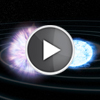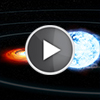CXC Home | Search | Help | Image Use Policy | Latest Images | Privacy | Accessibility | Glossary | Q&A
Illustrations of an AM CVn system
Quicktime MPEG
This series of artist's illustrations depicts what these systems are like now and what may happen to them in the future. The first still shows the current state of the binary that contains one white dwarf (on the right) with about one-fifth the mass of the Sun and another much heavier and more compact white dwarf about five or more times as massive (unlike sun-like stars, heavier white dwarfs are smaller). As the two white dwarfs orbit around each other, gravitational waves will be given off causing the orbit to become tighter. Eventually the smaller, heavier white dwarf will start pulling matter from the larger, lighter one, as shown in the second still, forming an AM CVn system. This process continues until so much matter accumulates on the more massive white dwarf that a thermonuclear explosion may occur in about 100 million years (final still).
[Runtime: 00:12]
Quicktime MPEG
This series of artist's illustrations depicts what these systems are like now and what may happen to them in the future. The first still shows the current state of the binary that contains one white dwarf (on the right) with about one-fifth the mass of the Sun and another much heavier and more compact white dwarf about five or more times as massive (unlike sun-like stars, heavier white dwarfs are smaller). As the two white dwarfs orbit around each other, gravitational waves will be given off causing the orbit to become tighter. Eventually the smaller, heavier white dwarf will start pulling matter from the larger, lighter one, as shown in the second still, forming an AM CVn system. This process continues until so much matter accumulates on the more massive white dwarf that a thermonuclear explosion may occur in about 100 million years (final still).
[Runtime: 00:12]
(Credit: NASA/CXC/A. Hobart, Illustration: NASA/CXC/M.Weiss)
Tour of AM CVn
Quicktime MPEG With closed-captions (at YouTube)
In the middle of the twentieth century, an unusual star was spotted in the constellation of Canes Venatici (Latin for "hunting dogs"). Years later, astronomers determined that this object, dubbed AM Canum Venaticorum (or, AM CVn, for short), was, in fact, two stars. These stars revolve around each other every 18 minutes, and are predicted to generate gravitational waves - ripples in space-time predicted by Einstein.
Today, the name AM CVn represents a class of objects where one white dwarf star is pulling matter from a very compact companion star, such as a second white dwarf. (White dwarf stars are dense remains of Sun-like stars that have run out of fuel and collapsed to the size of the Earth.) The pairs of stars in AM CVn systems orbit each other extremely rapidly, whipping around one another in an hour, and in one case as quickly as 5 five minutes. By contrast, the fastest orbiting planet in our Solar System, Mercury, orbits the Sun once every 88 days.
Despite being known for almost 50 years, the question has remained: where do AM CVn systems come from? New X-ray and optical observations have begun to answer that with the discovery of the first known systems of double stars that astronomers think will evolve into AM CVn systems.
Observations with optical telescopes on the ground helped identify two systems, known as J0751 and J1741, that contain two white dwarfs and determined their masses. Scientists used Chandra to help rule out the possibility that J0751 and J1741 contained neutron stars. A neutron star - which would disqualify it from being a possible parent to an AM CVn system - would give off strong X-ray emission due to its magnetic field and rapid rotation. No X-ray emission was seen from either system, thus convincing scientists that these were going to evolve into AM CVn in the future.
As we mentioned before, AM CVn systems are of interest to scientists because they are predicted to be sources of gravitational waves. This is important because even though such waves have yet to be detected, many scientists and engineers are working on instruments that should be able to detect them in the near future. This will open a significant new observational window to the universe.
[Runtime: 02:55]
Quicktime MPEG With closed-captions (at YouTube)
In the middle of the twentieth century, an unusual star was spotted in the constellation of Canes Venatici (Latin for "hunting dogs"). Years later, astronomers determined that this object, dubbed AM Canum Venaticorum (or, AM CVn, for short), was, in fact, two stars. These stars revolve around each other every 18 minutes, and are predicted to generate gravitational waves - ripples in space-time predicted by Einstein.
Today, the name AM CVn represents a class of objects where one white dwarf star is pulling matter from a very compact companion star, such as a second white dwarf. (White dwarf stars are dense remains of Sun-like stars that have run out of fuel and collapsed to the size of the Earth.) The pairs of stars in AM CVn systems orbit each other extremely rapidly, whipping around one another in an hour, and in one case as quickly as 5 five minutes. By contrast, the fastest orbiting planet in our Solar System, Mercury, orbits the Sun once every 88 days.
Despite being known for almost 50 years, the question has remained: where do AM CVn systems come from? New X-ray and optical observations have begun to answer that with the discovery of the first known systems of double stars that astronomers think will evolve into AM CVn systems.
Observations with optical telescopes on the ground helped identify two systems, known as J0751 and J1741, that contain two white dwarfs and determined their masses. Scientists used Chandra to help rule out the possibility that J0751 and J1741 contained neutron stars. A neutron star - which would disqualify it from being a possible parent to an AM CVn system - would give off strong X-ray emission due to its magnetic field and rapid rotation. No X-ray emission was seen from either system, thus convincing scientists that these were going to evolve into AM CVn in the future.
As we mentioned before, AM CVn systems are of interest to scientists because they are predicted to be sources of gravitational waves. This is important because even though such waves have yet to be detected, many scientists and engineers are working on instruments that should be able to detect them in the near future. This will open a significant new observational window to the universe.
[Runtime: 02:55]
(Credit: NASA/CXC/A. Hobart)
Return to J075141 and J174140 (December 17, 2013)




